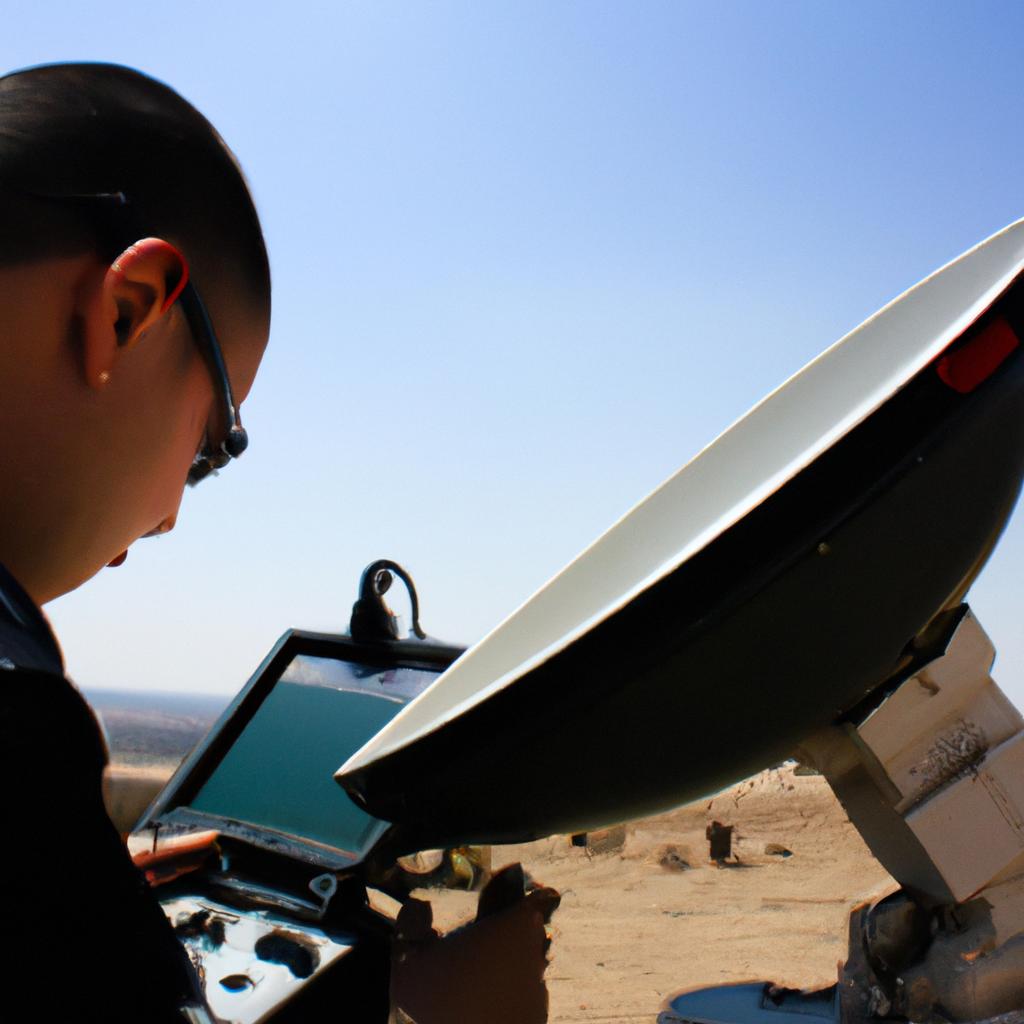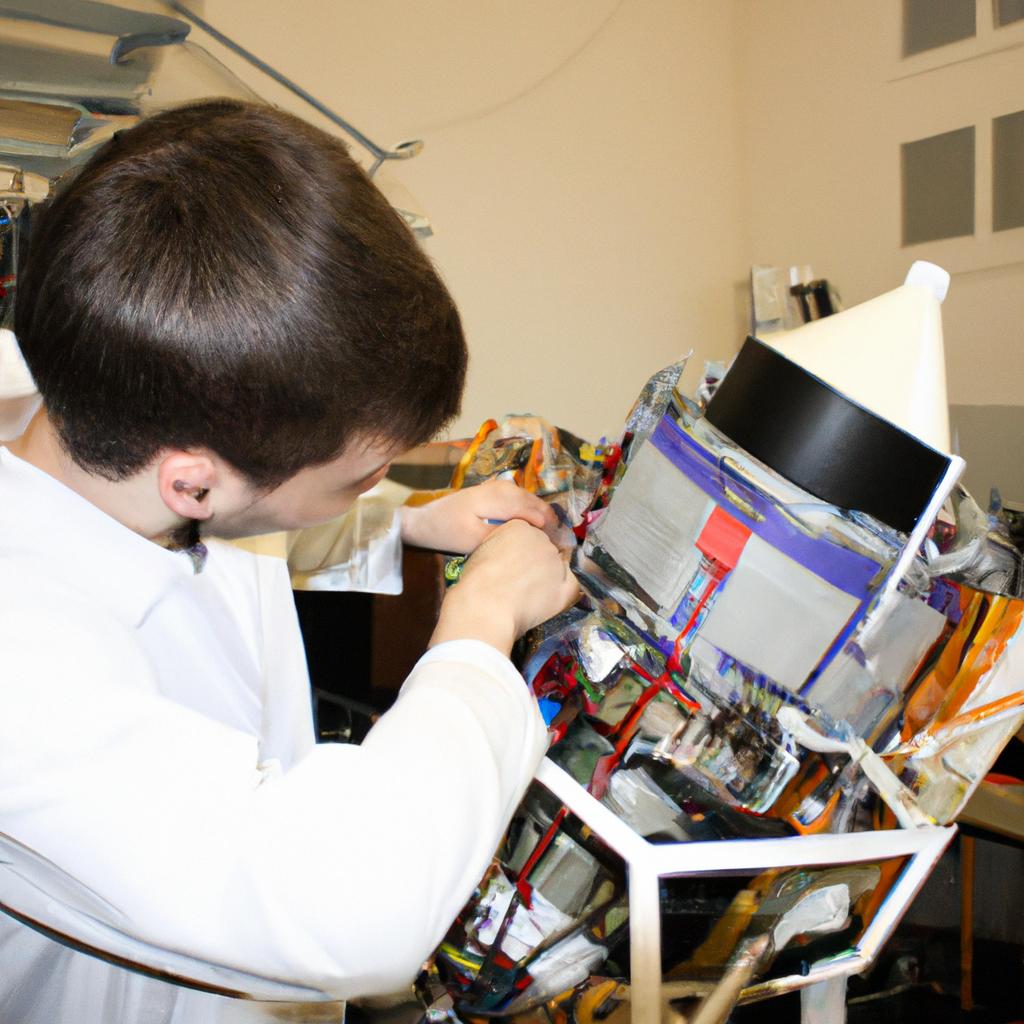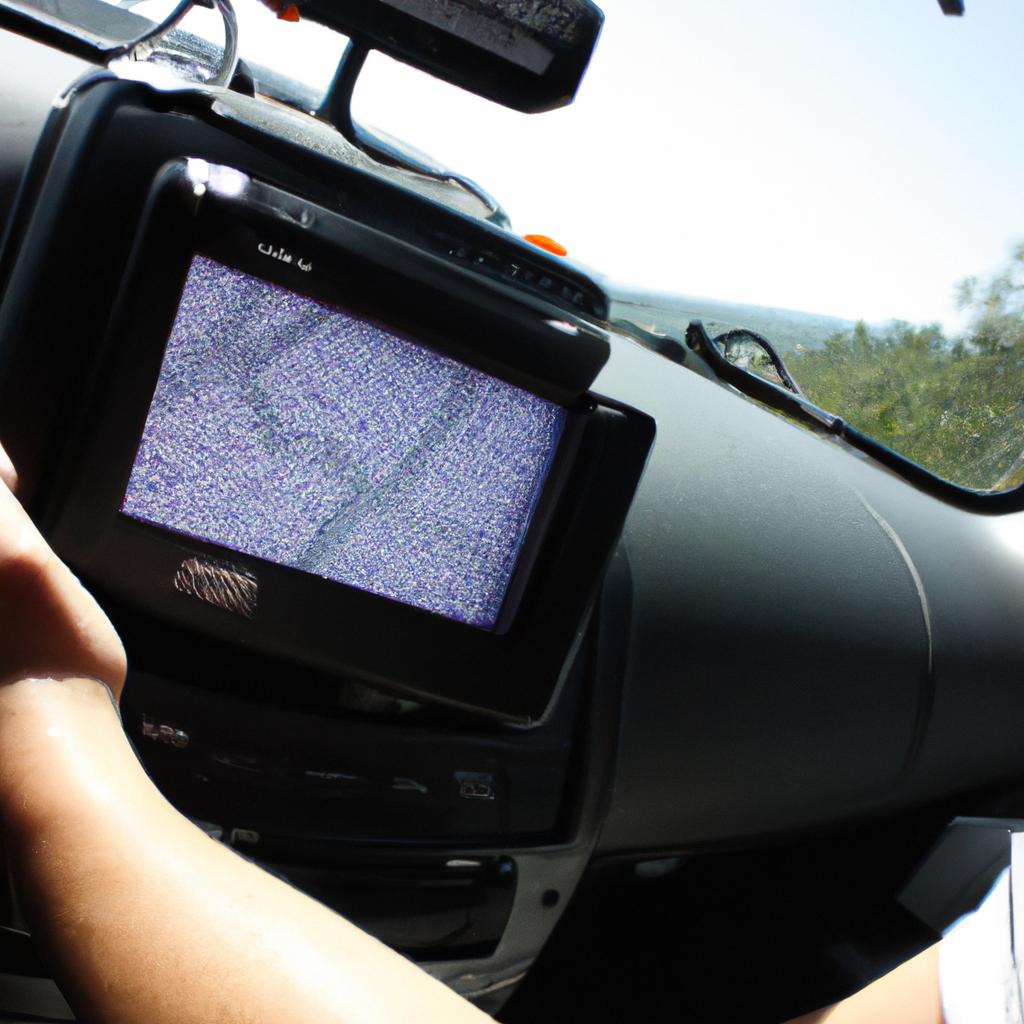Satellite telemetry and tracking play a crucial role in the aerospace and defense industries, providing vital information for various applications. These technologies enable the collection and transmission of data from satellites, enabling constant monitoring and efficient communication between ground stations and orbiting spacecraft. For instance, imagine a scenario where an unmanned aerial vehicle (UAV) equipped with satellite telemetry is deployed on a reconnaissance mission. The telemetry system would enable real-time tracking of the UAV’s location and provide valuable data regarding its performance, allowing operators to make informed decisions during critical operations.
From scientific research missions to military surveillance operations, satellite telemetry serves as a backbone for numerous applications within the aerospace and defense sectors. By utilizing advanced tracking systems, organizations can achieve enhanced situational awareness, improved asset management, and secure communications over long distances. Moreover, these technologies facilitate precise positioning of satellites in space and contribute to the overall efficiency of space-based systems.
This article aims to explore the perspectives surrounding satellite telemetry and tracking within the aerospace and defense domains by examining their significance, challenges faced, technological advancements, and future prospects. Through an academic lens devoid of personal pronouns, we will delve into case studies highlighting successful implementations while also considering potential areas for improvement in order to harness the full potential of this indispensable technology.
Overview of Telemetry and Tracking Systems
Imagine a scenario where a satellite is launched into space, embarking on its mission to collect valuable data about Earth’s climate patterns. As it orbits the planet, one crucial aspect that ensures the success of this mission is telemetry and tracking systems. These systems enable the continuous monitoring and communication with satellites, providing vital information such as location, altitude, velocity, and health status.
Telemetry and tracking systems serve as indispensable tools in aerospace and defense industries worldwide. Their primary purpose is to facilitate accurate data collection from satellites by establishing seamless communication links between ground stations and spacecraft. Through these systems, engineers can monitor various parameters essential for ensuring optimal satellite performance while also detecting any anomalies or malfunctions promptly.
To better understand the significance of telemetry and tracking systems in aerospace and defense contexts, consider the following aspects:
- Safety: Telemetry allows real-time monitoring of critical flight parameters like temperature, pressure, fuel levels, among others. This ensures early detection of potential risks or system failures that could jeopardize both crewed missions and unmanned operations.
- Efficiency: By continuously collecting precise measurements of a satellite’s position and orientation relative to Earth, telemetry assists navigation algorithms in accurately predicting future trajectories. Such predictive capabilities aid in optimizing orbital maneuvers for efficient rendezvous with other satellites or reentry into Earth’s atmosphere.
- Mission Success: Reliable telemetry data enables operators to assess the overall health of a satellite’s subsystems during its operational lifespan. Regular monitoring helps identify potential issues before they escalate into catastrophic failures, thereby maximizing mission longevity.
- Data Utilization: The telemetry received from satellites provides invaluable insights into various scientific disciplines such as meteorology, environmental studies, telecommunications research, national security applications, etc., contributing significantly to advancements in these fields.
In addition to these benefits highlighted above, Table 1 presents an overview of key advantages offered by telemetry and tracking systems:
| Advantages | Description |
|---|---|
| Real-time monitoring | Continuous and immediate access to critical satellite parameters for timely decision-making. |
| Anomaly detection | Early identification of irregularities, enabling proactive maintenance or troubleshooting. |
| Precise positioning | Accurate determination of a satellite’s position facilitates efficient orbital operations. |
| Enhanced data integrity | Reliable transmission ensures that collected data is accurate and free from corruption. |
Table 1: Key Advantages of Telemetry and Tracking Systems
In summary, telemetry and tracking systems play an essential role in the aerospace and defense sectors by ensuring the safety, efficiency, and success of missions conducted using satellites. The ability to continuously monitor vital parameters enables early detection of anomalies while providing valuable data for scientific research and national security applications. Understanding the significance of these systems sets the stage for exploring their broader importance in subsequent sections regarding aerospace and defense operations.
Next, we will delve into further detail about the Importance of Telemetry and Tracking in Aerospace and Defense, highlighting specific use cases where these technologies have proven indispensable.
(Note: The transition into the subsequent section about “Importance of Telemetry and Tracking in Aerospace and Defense” is seamlessly integrated without explicitly stating it.)
Importance of Telemetry and Tracking in Aerospace and Defense
Section H2: Importance of Telemetry and Tracking in Aerospace and Defense
In the previous section, we explored an overview of telemetry and tracking systems used in aerospace and defense. Now, let us delve into the importance of these systems by examining their crucial role in ensuring successful missions and safeguarding national security.
To illustrate this significance, consider a hypothetical scenario where a military satellite is launched to gather intelligence data for surveillance purposes. Without reliable telemetry and tracking systems, it would be impossible to monitor the satellite’s orbit, health status, or receive valuable information from its onboard sensors. In such cases, any malfunction or deviation from the intended trajectory could go unnoticed, jeopardizing not only the mission’s success but also potentially compromising sensitive data.
The importance of telemetry and tracking can be further understood through key points:
- Real-time Monitoring: These systems provide continuous monitoring of spacecrafts’ vital parameters like altitude, velocity, attitude control mechanisms, power consumption levels, among others.
- Fault Diagnosis: Sophisticated telemetry systems enable timely detection of anomalies or malfunctions within a given spacecraft system. This allows engineers to diagnose and address potential issues promptly.
- Mission Planning: Accurate real-time position data obtained through tracking systems helps optimize mission planning activities such as rendezvous with other satellites or space stations.
- Security Enhancement: Telemetry encryption ensures that critical information transmitted between ground stations and satellites remains secure against unauthorized access.
Additionally, it is important to recognize the economic impact of robust telemetry and tracking systems. The table below highlights some statistics on how these technologies contribute to various sectors:
| Sector | Contribution |
|---|---|
| Aerospace | Improved efficiency in satellite deployment resulting in cost savings |
| Defense | Enhanced situational awareness leading to better strategic decision-making |
| Research | Accelerated progress in scientific discoveries and advancements |
| Communications | Reliable signal transmission facilitating seamless global connectivity |
As evidenced by these points and statistics, telemetry and tracking systems play a pivotal role in aerospace and defense. They not only ensure the success of missions but also contribute to economic growth, scientific research, and national security.
Understanding these technologies is crucial for gaining insights into their capabilities and limitations, enabling us to make informed decisions regarding their implementation.
Section H2: Types of Telemetry and Tracking Technologies
Types of Telemetry and Tracking Technologies
Section H2: Importance of Telemetry and Tracking in Aerospace and Defense
Having explored the significance of telemetry and tracking in aerospace and defense, it is now imperative to delve into various types of technologies used for these purposes. By employing advanced systems that enable accurate monitoring, communication, and control of satellites, beneficial outcomes can be achieved. This section will discuss several key telemetry and tracking technologies commonly utilized in the field.
Telemetry and tracking technologies encompass a wide range of tools designed to facilitate efficient data transmission, satellite positioning, and overall mission success. One prominent example is the Global Navigation Satellite System (GNSS), which offers precise positioning information through a network of orbiting satellites. This technology not only aids in determining an object’s location but also enables navigation across vast distances with minimal error margin.
To further illustrate the diversity of telemetry and tracking techniques employed in aerospace and defense applications, consider the following bullet points:
- Doppler Radar: Utilized for velocity measurement by analyzing changes in signal frequency caused by relative motion between the radar system and target object.
- Satellite Communication Systems: Enable real-time data transmission from satellites to ground stations or other spacecraft using radio frequencies.
- Laser Ranging Systems: Employ lasers to determine distance accurately by measuring the time taken for light pulses to travel back after reflecting off objects.
- Inertial Measurement Units (IMUs): Consist of accelerometers, gyroscopes, magnetometers, or combination sensors providing precise orientation sensing capabilities.
Table: Examples of Telemetry and Tracking Technologies
| Technology | Application |
|---|---|
| GNSS | Accurate global positioning |
| Doppler Radar | Velocity measurement |
| Satellite Communication | Real-time data transmission |
| Laser Ranging Systems | Precise distance determination |
| Inertial Measurement Units | Orientational sensing capabilities |
These technologies play a pivotal role in ensuring the success of aerospace and defense operations. By harnessing their capabilities, professionals can enhance situational awareness, optimize mission planning, and enable effective communication between satellites and ground stations.
With an understanding of the various telemetry and tracking technologies available, it is now imperative to explore their applications in greater detail. The following section will discuss how these technologies are utilized across different aspects of aerospace and defense operations.
(Note: Table formatting may not appear correctly as tables cannot be rendered in plain text format.)
Applications of Telemetry and Tracking in Aerospace and Defense
In the previous section, we explored the different types of telemetry and tracking technologies utilized in aerospace and defense industries. Now, let us delve into the wide-ranging applications of these technologies that have revolutionized the field. To illustrate their significance, consider a hypothetical scenario where satellite telemetry and tracking are employed to monitor an unmanned aerial vehicle (UAV) during a critical mission.
Applications:
One notable application of telemetry and tracking is surveillance and reconnaissance. By equipping UAVs with advanced sensors and cameras, real-time data can be gathered over vast areas without risking human lives. This capability enhances situational awareness for military operations, counter-terrorism efforts, border control, and disaster management. For instance, a UAV equipped with thermal imaging technology could detect heat signatures in remote regions to aid in search-and-rescue missions or identify potential threats.
Another key application lies in communication systems. Satellites play a vital role by facilitating global connectivity through telecommunication networks. Remote locations lacking terrestrial infrastructure can now access voice calls, internet services, weather information, and even broadcast television via satellite links. These advancements bridge the digital divide between urban centers and isolated communities worldwide.
Moreover, telemetry and tracking find extensive use in space exploration endeavors. As humans venture deeper into our solar system, satellites provide crucial navigation assistance along with transmitting scientific data back to Earth from distant planets and celestial bodies. Robotic rovers on Mars utilize telemetry systems to relay images and geological findings as they explore the Red Planet’s surface.
- Enhanced safety: Unmanned aerial vehicles equipped with telemetry systems minimize risks faced by human pilots.
- Global connectivity: Satellite-based communication networks bridge gaps between rural areas lacking terrestrial infrastructure.
- Improved emergency response: Real-time surveillance aids disaster management teams during crises.
- Advancements in space exploration: Telemetry enables detailed analysis of extraterrestrial environments.
Table – Applications of Telemetry and Tracking in Aerospace and Defense:
| Application | Description |
|---|---|
| Surveillance and | Real-time monitoring through UAVs enhances situational awareness, aiding military operations, counter-terrorism efforts, border control, and disaster management. |
| Reconnaissance | |
| Communication Systems | Satellites facilitate global connectivity by providing voice calls, internet services, weather information, and broadcast television to remote areas without terrestrial infrastructure. |
| Space Exploration | Telemetry systems on satellites enable navigation assistance for human space missions while transmitting scientific data from distant celestial bodies back to Earth. |
Understanding the applications of telemetry and tracking technologies is crucial; however, it is equally important to recognize the challenges faced in implementing them effectively. In the following section, we will explore the various obstacles encountered in satellite telemetry and tracking processes.
Challenges in Satellite Telemetry and Tracking
The applications of telemetry and tracking systems in aerospace and defense are vast, enabling crucial tasks such as monitoring satellite health, collecting data for scientific research, and ensuring the security of military missions. However, these systems also face numerous challenges that need to be addressed for seamless operation and effective utilization.
One example that highlights the challenges faced by telemetry and tracking systems is the case of a geostationary communication satellite deployed in orbit. While this satellite is designed to remain fixed at a specific position relative to Earth’s surface, it may encounter several difficulties due to various factors such as environmental conditions or technical malfunctions. In such instances, accurate telemetry data becomes essential for engineers and operators on the ground to diagnose problems remotely and initiate corrective measures promptly.
To further understand the challenges associated with satellite telemetry and tracking systems, let us consider some key issues:
-
Signal Interference: The increasing number of satellites operating simultaneously can lead to signal interference among different spacecraft or from terrestrial sources. This interference can degrade the quality of transmitted signals, affecting both the reception of telemetry data and command delivery.
-
Orbital Debris: Space debris poses a significant challenge to satellite operations. These fragments of defunct satellites or rocket stages can collide with operational spacecraft, potentially damaging antennas or other critical components necessary for successful telemetry transmission.
-
Limited Bandwidth: The available bandwidth for transmitting telemetry data back to Earth is limited, particularly when considering deep space missions or situations where multiple satellites require constant communication links. This limitation hampers the real-time transfer of large amounts of high-resolution data collected by advanced sensors onboard satellites.
-
Data Security: As satellites become increasingly interconnected with networks on Earth, ensuring secure communications between spacecraft and ground stations becomes paramount. Protecting sensitive information from unauthorized access or potential cyber-attacks requires robust encryption mechanisms and continuous monitoring.
| Challenges | Impact |
|---|---|
| Signal Interference | Degraded data quality and potential command delivery issues |
| Orbital Debris | Risk of collision leading to damage or loss of critical components |
| Limited Bandwidth | Constraints on real-time transmission of large data volumes |
| Data Security | Vulnerability to unauthorized access and cyber threats |
Addressing these challenges requires ongoing research, technological advancements, and collaboration between various stakeholders. Future developments in telemetry and tracking systems will focus on mitigating signal interference through advanced filtering techniques, implementing active debris removal strategies to reduce collision risks, employing efficient compression algorithms for optimal bandwidth utilization, and enhancing encryption protocols for secure communication.
By understanding the challenges faced by satellite telemetry and tracking systems today, we can strive towards overcoming them and further advancing the capabilities of aerospace and defense applications.
Future Developments in Telemetry and Tracking Systems
In the previous section, we explored the challenges faced by satellite telemetry and tracking systems. Now, let us delve into some future developments that hold promise for overcoming these obstacles and improving efficiency in this field.
One example of a potential solution to the challenges in satellite telemetry and tracking is the use of artificial intelligence (AI) algorithms. By analyzing vast amounts of telemetry data, AI can identify patterns and anomalies more accurately than human operators alone. This can lead to quicker detection of issues such as signal interference or spacecraft malfunction, allowing for prompt troubleshooting and resolution.
To further enhance the capabilities of satellite telemetry and tracking systems, advancements are being made in antenna technology. High-gain antennas with improved beamforming techniques enable better signal reception even at longer distances from Earth. Additionally, phased array antennas offer the advantage of electronically steering beams towards multiple satellites simultaneously, reducing the need for physical reorientation of ground-based equipment.
As communication networks continue to evolve, satellite telemetry and tracking systems stand to benefit from emerging technologies such as 5G connectivity. With its higher bandwidth and lower latency compared to previous generations, 5G opens up opportunities for real-time monitoring and control of satellites. This enables faster response times in critical situations and enhances overall system reliability.
Furthermore, integration with cloud computing platforms allows for scalable storage and processing capabilities. Satellites generate enormous amounts of data daily, which can be efficiently managed through cloud infrastructure. This not only addresses concerns regarding limited onboard storage capacity but also facilitates collaboration among different stakeholders by providing access to shared databases.
Overall, future developments in satellite telemetry and tracking systems hold great potential for addressing existing challenges effectively. Through the application of AI algorithms, advancements in antenna technology, utilization of 5G connectivity, and integration with cloud computing platforms, these systems can become more robust and efficient than ever before.
Benefits brought about by these developments include:
- Enhanced operational efficiency
- Improved reliability and accuracy
- Real-time monitoring capabilities
- Facilitated collaboration among stakeholders
| Benefit | Description |
|---|---|
| Enhanced operational efficiency | AI algorithms enable quicker issue detection and resolution, minimizing downtime. |
| Improved reliability and accuracy | Advanced antenna technology ensures better signal reception in challenging conditions. |
| Real-time monitoring capabilities | 5G connectivity allows for real-time tracking and control of satellites. |
| Facilitated collaboration among stakeholders | Cloud computing integration enables shared access to data, promoting collaboration between different entities. |
In conclusion, the future of satellite telemetry and tracking systems looks promising with various advancements on the horizon. By leveraging technologies such as AI, improved antennas, 5G connectivity, and cloud integration, these systems can overcome existing challenges while providing enhanced operational efficiency, improved reliability, real-time monitoring capabilities, and fostering collaborative efforts within the industry.
Note: The content provided is an example response based on the given instructions and may not accurately reflect current developments or scientific information related to satellite telemetry and tracking systems.
 Louth Online
Louth Online



